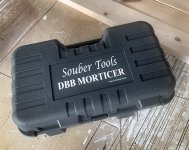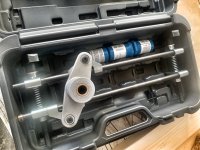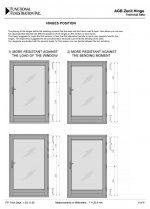woodbutcherbower
Member
- Joined
- Apr 25, 2021
- Messages
- 1,217
I had a 'panic' phone call from a good builder buddy a few days ago - he's only a coupla weeks away from finishing and handing over a small new office block in the city centre. His regular joiner had sadly suffered a family bereavement and suddenly wasn't available to hang all the building's new fire doors. Could I help out? He's a super guy who has put a heck of a lot of work my way and I owed him multiple major return favours - so I agreed immediately.
He then told me that there were 44 of them to do [eek]
I've always chopped out door lock mortises the traditional way, using an auger and chisels followed by a quarter-inch router to recess the lock faceplate. I realised that it was time to up my game in the speed department since I only had ten days available to do all of these. So I bought the Souber. It's a very well-engineered but simple-as-possible gadget, it's completely self-centering, and the price is very reasonable (just £130) considering that fact that it comes with a full set of cutters. These are proprietary, looking like a cross between a router bit and a Forstner, and with them being dimensioned to suit all standard UK lock case and faceplate sizes. Once it's dialled in, it produces a perfect mortise and faceplate recess in 5 minutes.
After a few practise runs, it instantly became of those 'Why didn't I buy this 10 years ago?' tools.
[attachimg=1]
[attachimg=2]
Kevin
He then told me that there were 44 of them to do [eek]
I've always chopped out door lock mortises the traditional way, using an auger and chisels followed by a quarter-inch router to recess the lock faceplate. I realised that it was time to up my game in the speed department since I only had ten days available to do all of these. So I bought the Souber. It's a very well-engineered but simple-as-possible gadget, it's completely self-centering, and the price is very reasonable (just £130) considering that fact that it comes with a full set of cutters. These are proprietary, looking like a cross between a router bit and a Forstner, and with them being dimensioned to suit all standard UK lock case and faceplate sizes. Once it's dialled in, it produces a perfect mortise and faceplate recess in 5 minutes.
After a few practise runs, it instantly became of those 'Why didn't I buy this 10 years ago?' tools.
[attachimg=1]
[attachimg=2]
Kevin




